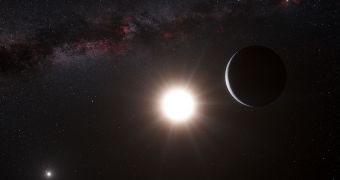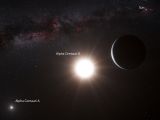Exoplanets aren't big news anymore. A planet with four suns around it was just found, then a system with five Earth-sized planets packed in so close to their star no one ever though it was possible.
But as more exoplanets are discovered, both huge gas giants and rocky ones the size of Earth or smaller, in far and distant places in our galaxy, a lot of people have been asking an obvious question, what about the "near" places like Alpha Centauri, the closest star to the Solar System. Why aren't scientists looking there first?
Well, they've looked and, lo and behold, they did find a planet. Not just any planet, a planet about the size of Earth circling a star similar to the sun.
It's the lightest planet found so far orbiting a sun-like star, but the big news here is that, yes, we do have next-door neighbors.
Alpha Centauri is the closest star system to Earth and one of the brightest in the southern sky. It's actually made up of three stars, Alpha Centauri A and Alpha Centauri B make up a binary system.
The third, Alpha Centauri C or Proxima Centauri, a red dwarf, is probably gravitationally linked to the two, but is not visible with the naked eye even though it's closer to the sun than the other two.
The astronomers at the European Southern Observatory have announced that they have discovered an Earth-sized planet around Alpha Centauri B.
The planet has been dubbed Alpha Centauri Bb. Planets get lower case letters assigned to them, starting at 'b,' for some reason.
Before you ask, no, the planet can't harbor life, at least not life as we know it, it has a very close orbit to its star, closer than Mercury, and scientists believe it is extremely hot and probably has a molten rock surface.
It orbits at 6 million km, 3.6 million miles from its star. Mercury sits at 58 million km, 36 million miles from the sun, the Earth at 150 million km, 93 million miles.
It goes around Alpha Centauri B in just 3.24 days and weighs about 1.13 times the mass of the Earth.
You'd think that finding a planet so close to the sun would be easier, but because it is so small, its influence on its star is minimal.
Still, researchers were able to detect a Doppler shift cycle in the star's light indicating that there is an object pulling it slightly as it circles around it, due to gravity.
The effect is very, very small and researchers have only now managed to detect it, even though astronomers have been studying the Alpha Centauri system for years.
To give you an idea, the planet pushes and pulls the star by 51 cm per second, or 1.8 km/h, 1.1 mph. It's this movement that the team detected, from 4.37 light years away.
"Our observations extended over more than four years using the HARPS instrument and have revealed a tiny, but real, signal from a planet orbiting Alpha Centauri B every 3.2 days," Xavier Dumusque, the lead author on the paper describing the discovery, wrote. "It’s an extraordinary discovery and it has pushed our technique to the limit!"
The next step is searching for an Earth-sized planet within the habitable zone of its parent star. It is believed that the Alpha Centauri system could harbor such a planet. Still, Alpha Centauri Bb is the first and, obviously, the only Earth-size planet found around a star similar to the sun.

 14 DAY TRIAL //
14 DAY TRIAL // 
